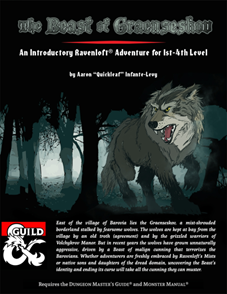 Aaron “Quickleaf” Infante-Levy’s adventure The Beast of Graenseskov is a grand investigative adventure set in eastern Barovia. A large wolf-like creature has begun to terrorise the lands around the Graenseskov forest, and it is the player characters who need to discover what the creature is and how to stop it.
Aaron “Quickleaf” Infante-Levy’s adventure The Beast of Graenseskov is a grand investigative adventure set in eastern Barovia. A large wolf-like creature has begun to terrorise the lands around the Graenseskov forest, and it is the player characters who need to discover what the creature is and how to stop it.
The 80-page adventure describes the inhabitants of the land, the locations, and the events that can occur while the investigation is taking place. The structure of the investigation is fascinating: there are four suspects, with clues leading to each one. The identity of which one is actually the Beast is determined by the DM, either by choice or by random determination; the adventure also allows the use of a Tarokka deck to randomise the Beast’s identity and goals. A special set of “critical” clues – one for each suspect – must be found to positively identify the killer.
I’m impressed by the cleverness of this construction, but I am dubious about its actual playability. The fact is that, especially in multi-session games, players are tremendously good at avoiding or misinterpreting clues. Most investigations need to be quite “obvious” – with back-up ways of discovering the solution – for the average player to solve them. So, my initial reaction is that this adventure is going to be quite challenging for the DM to run. However, I hasten to add that I haven’t DMed this adventure. So, your players might have no trouble with it.
That said, in one of the storyline’s there is one clue which is absolutely essential for the players to get… and they are lied to about it. A poor Insight check and they’ve failed the investigation. Hmm.
Although the adventure is billed as an introductory adventure, I expect it needs a skilled DM to run it well. There’s a lot of detail, and the adventure is filled with fascinating locations and characters. There are a lot of stories for the characters to discover in addition to the main plot, and the adventure is much the better for it.
It’s a real sandbox adventure, where the characters can go where they like. Events are provided to drag the players back to the threat at hand if they get distracted – there’s nothing like finding a mauled corpse to focus your attention.
There’s one significant editing failure where the text repeats on two pages (pages 11 & 12). The product is mostly well-written, although I would prefer a sparer, less flowery prose style. Occasionally contradictions turn up in the text – the people of the Graenseskov have an understanding with the wolves, yet they have regular wolf hunts? It doesn’t quite line up properly. There are the odd misspelling and poor phrasing choice, but it’s better than many other adventures I’ve read.
Incidentally, I find it most unlikely that a molar would be left lodged in something. An incisor or (most likely) a canine tooth? Absolutely. A flat molar? Nope!
There’s a lot to like and admire about The Beast of Graenseskov. It’s a tremendous achievement, and one with a lot of play value. I suspect you’ll need to do some tinkering with the core story, however. Aaron describes it as his love-letter to Ravenloft – and a mighty love-letter it is!

I got this after your review, very nice adventure with some good ideas.
I think I agree with your points though, you really need to have read it in detail before trying to run it. I feel like some of the format could have been moved around to help keep useful information together, like moving the major NPC introductions before the meeting with the boyar so you have a grasp of the characters before the PC’s talk with him. Maybe include some page references next to characters in case you need to quickly brush up on them.
I also personally would have moved the random encounters/map locations to after the meat of chapter one (the investigations), but that’s because I like to get to the heart of the adventure quickly and then move onto side/map locations.
Thanks for the review, Merric. I really enjoy your reviewing style!
Akuma, I’m the author of the adventure. Thanks for checking it out! I fully agree that the organization presents challenges. Between the simple layout, the index of NPCs with page numbers, and the DM’s cheat cheet with its clue checklist and “quick play” suggestions, I did everything in my power to make it easier on the DM to run. Eas-ier, not easy. It’s not a “pick up and run” sort of adventure by its very nature: I went with sandbox approach to a mystery — a genre that is usually given more of a linear progression in adventures. If you’re interested in following another DM’s playthrough of the adventure, check out: https://fearandloathinginravenloft.wordpress.com/